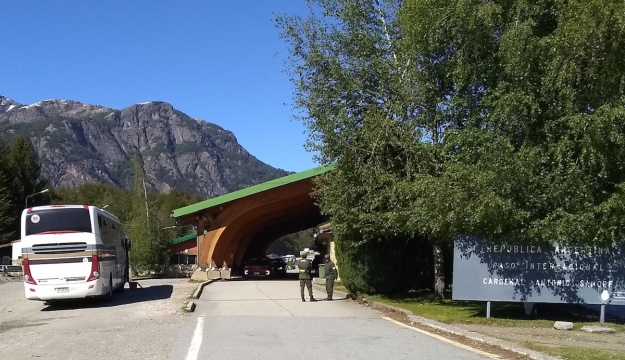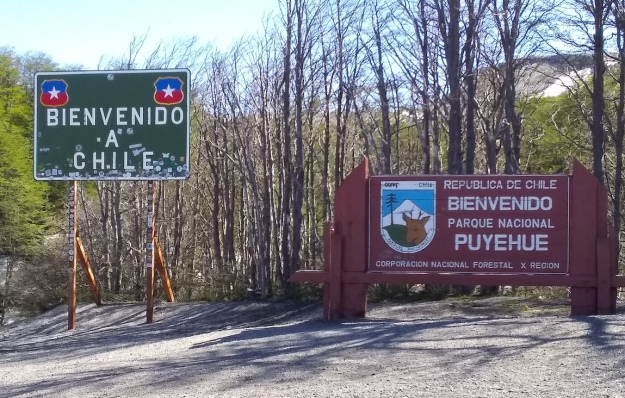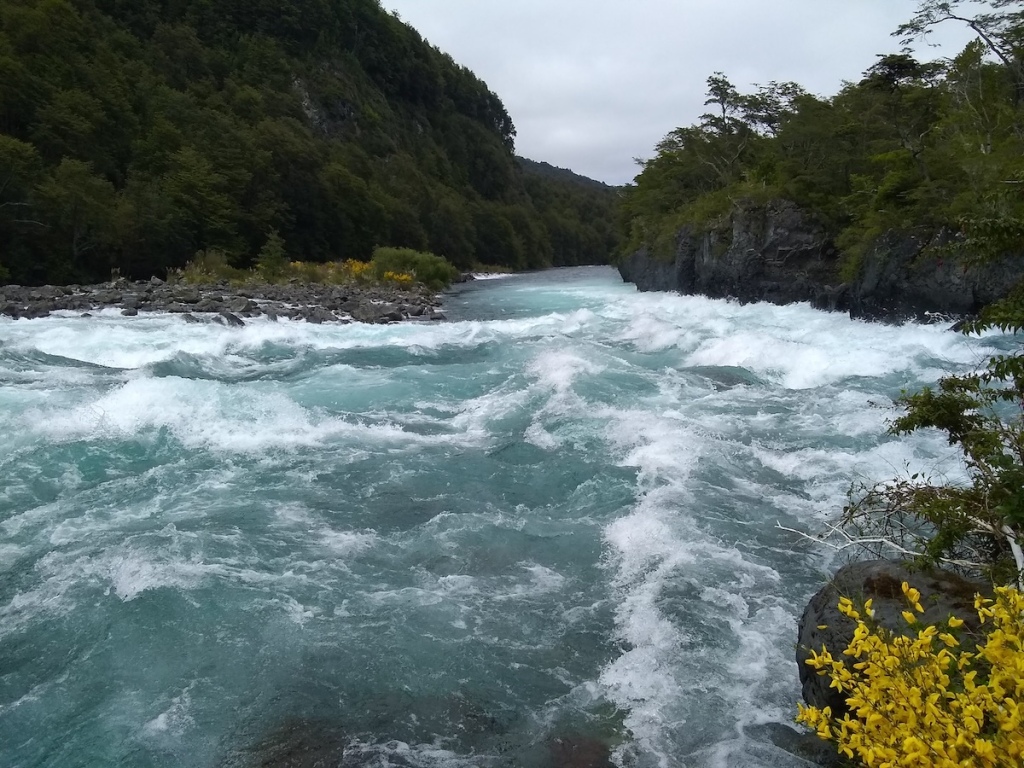by Jim and Melanie
The next part of our journey started with a lengthy bus ride that involved crossing the border between Argentina and Chile, high in the Andes Mountains. The crossing was a rather complex process. Our tour leader had already compiled a list of our names and passport numbers to show the authorities. We were told to have our passports in hand. The process could take a long time if the crossing was busy. We were fortunate to have started our drive early and avoided the crowds at the border.
First, we stopped at the station operated by the Argentinian government. Our papers and passports were examined. Our luggage was removed from the bus and a dog checked it for suspicious smells. When we finished, we were free to use the banos before resuming our bus ride.

Some distance down the road was the actual border higher in the Andes. We stopped for photographs. We gathered for group pictures and got back on the bus. We weren’t finished crossing into Chile.

We were stopped again, this time at the checkpoint operated by the Chilean government. We got off the bus, presented papers and passports, and had our luggage and backpacks sniffed by a dog. This time, the dog handler wanted to impress us with how well the dog could do its job. She buried a little contraband amongst the backpacks for it to find. It was easy for the dog to find it next to Jim’s pack. We applauded and were allowed to leave.
One final thing needed to happen. Our bus driver and bus could not continue into Chile. We had to switch to a different bus and driver.
Scenery higher in the mountains was beautiful. In one portion of the drive we passed through a forest near a volcano that had erupted a few years earlier. The hot ash fall had stripped and killed all the taller mature trees as far as we could see. The top of that volcano is in the distance covered with snow in this photo.

We were many miles into Chile by the time for lunch. The bus pulled into a roadside stop out in the country. There was a small building offering a nice lunch for travelers. It was a quiet and pleasant place with flowers in the gardens nearby.
After lunch we all walked to a larger old building that said it was an auto museum. The owner was a collector of lots of memorabilia, especially Studebaker cars and trucks. What a unique place out in the countryside of Chile. There were dozens of them in several parts of the building.

Later that afternoon we arrived in the city of Puerto Varas on the shore of Lake Llanquihue. The city is famous for its German heritage and architecture. The view from our lakefront hotel was spectacular. On the left was Osorno Volcano and the more recently active Calbuco Volcano on the right.

We drove to visit the national park near Osorno the next morning for a closer look at the volcano and the rushing river and falls of Rio Petrohue.




Later in the afternoon we visited COMBAS – Conservatorio de Musica y Bellas Artes del Sur. Our travel company OAT supports the Grand Circle Foundation whose goal is to give back to the world we travel. The foundation has pledged or donated $250 million for more than 500 projects in 50 countries. COMBAS is a nonprofit, Music and Art school founded in 2018 by Director Jean Paul Harb, where the tuition from people who can afford to pay for lessons offset the costs for children that are not able to pay and in social risk.
We were met at the school by the director who explained how it got started. A student, 8-year-old Paola, was eager to play piano for us. He answered our many questions and then took us around the old building to see the rooms and some practicing students.



For the final activity of this busy day, we enjoyed a home-hosted dinner with a local family. We split into two smaller groups of seven each. Our group drove from Puerto Varas into the countryside several miles to the home of Carolina, George, and their 13-year-old son Gaspar. There are no photos in order to respect their privacy.
We gathered in the kitchen and toasted with Pisco Sours. They provided us with a small map of the US and asked us each to mark where we were from and tell a bit about the place, an exercise that generated a lot of laughter and Carolina’s declaration that we were the funniest group they had yet hosted.
Next, she and George taught us how to make fried empanadas. Melanie tried to recreate the recipe here. Click the image to enlarge and print. Note: we haven’t tested it at home yet! Let us know if you try it, and join us in the next post to learn about the island of Chiloe, Chile.


Love empanadas. Looks lovely. Odd place to find a collection of American cars.
I talked with the elderly man who owns them. He said it was his wife who insisted he set up the museum. She was more enthusiastic than he.
We have an empanada shop nearby. We visit it several times a year. Time for another visit.
Sounds like a grand adventure seeing beautiful places and meeting great people.
Empanadas are my favourite!! Since my Argentinian friend taught me how to make the real ones – and the cars! It looked like you were high up, in altitude I mean. What a great trip so far!
When we crossed the border at the Paso Cardenal Antonio Samoré, it was a little over 4300 ft altitude. The mountains of the south Andes aren’t very high compared to those farther north in Bolivia and Peru.
Oh ok. Topography fascinates me. I dream of a 3D topographical map of the world on a big table in a special room. Like an enormous pool table. Probably made out of magic papier mache. It would register every shift and every earthquake and reconfigure accordingly. Hmm . That reads like a short story. Maybe I will write it.
That’s beautiful scenery. It’s interesting that you had to change drivers at the border. The empanada filling is one of my favorites. The best empanadas are in Houston; we don’t have anyone making them closer to home now (that I know of). Having the recipe at hand almost tempts me to make some myself. Almost.
Great photos of the landscape and volcanos. Good to read about the music school and fun to see all those Studees.
Love the idea of having a meal with a host family!
They were very welcoming and gracious. They get visiting groups several times a month. It is a good source of income.